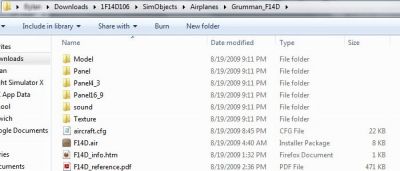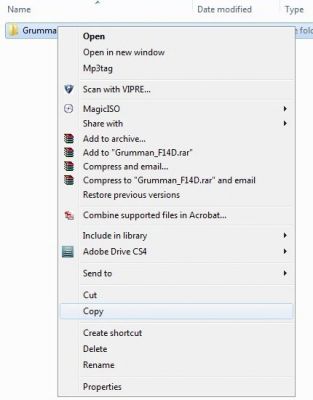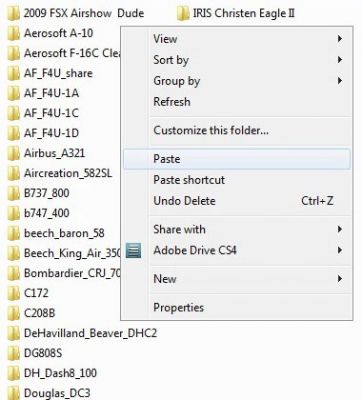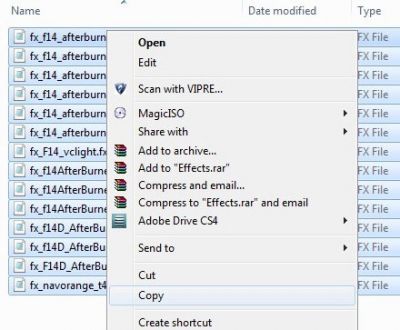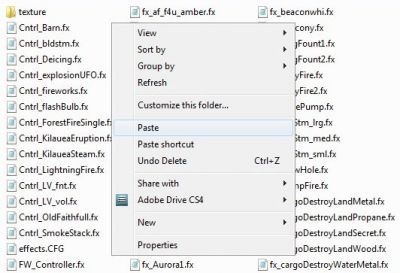One of the great features of Microsoft FSX is the huge number of addon aircraft available. This tutorial will show you step-by-step how to install addon aircraft. You can use any aircraft you like – this tutorial will use the Grumman F-14D Tomcat Package v1.06 (by Dino Cattaneo). You can locate it here:
https://flyawaysimulation.com/downloads/files/2940/fsx-grumman-f-14d-tomcat-mega-pack/
Windows 7/64 Bit is the operating system used in this tutorial. There are some tweaks you should make before continuing. Make sure “hidden files and folders” and file extensions are visible. The easiest way to do this is to go to the Control Panel, click Appearance and Personalization, look under Folder Options and click “Show hidden files and folders.” Then select the View tab.
Find “Hidden files and folders” and click the radio button “Show hidden, files, folders, and drives.” A little below, find and uncheck “hide extensions for known file types.”
A little housekeeping--many experienced FSX users like to keep downloads separate from the program—using the My Documents folder, for example. That way you can easily extract the download, and only copy what you need to FSX. If a zip file gets corrupted, you can easily delete it and start again without cluttering up your program files.
First Step
Download the Tomcat. Usually, airplane addons will be in the form of a zip (.zip) or archive (.rar) file. Windows 7 has its own extraction method. Simply right click the file and select “Extract All.” Some people prefer to use third party programs like 7-zip, WinZip or Win Rar.
Occasionally .exe or .msi files are used to package the addon. In that case, it’s just a matter of double-clicking the file and letting it install itself. Caution – all executable files should be scanned with your anti-virus program before launching.
This graphic shows an example of extracting the download, in this case using the WinRar program.
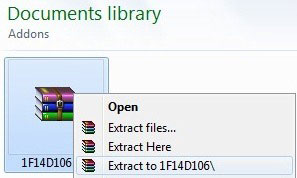
Extracting an archive with WinRAR.
Second Step
Take a quick inventory of the file contents. Remember that you cannot just copy the whole unzipped file “as-is” into FSX. Each of the components must be copied into the proper FSX file in the program folders located at:
C:Program FilesMicrosoft GamesMicrosoft Flight Simulator X
For 64 Bit Vista or Windows 7 systems look for:
C:Program Files (x86) Microsoft GamesMicrosoft Flight Simulator X
To make the addon operate properly, the minimum folders needed are model, texture, panel, and sound. Often there is more than one panel folder, depending on the aircraft. Two other critical files are “aircraft.cfg” and an .air file named after the addon. For example, the Tomcat file is called F14D.air. Here is the main function of the folders and files:
Folders
Model - contains .mdl and .cfg files for the cockpit, interior and exterior.
Texture - Every image and texture is contained in this folder. These are the components that “paint” the realistic skins of objects and structures in the program.
Panel - contains the panels used by the model. Some addons, like the Tomcat, have multiple panel folders.
Sound - .wav and .cfg files that help determine all sounds including ATC, engine noise and more.
Soundai - you may see this sound folder which is used for Artificial Intelligence versions.
Files
Aircraft.cfg - This is the main configuration file that determines how the aircraft operates.
.Air file - Determines flying characteristics.
You may see a few other files that are used by the program as reference (example: "name of addon"_check/ref.htm).
If there is an Effects folder, see the next step for more information. In the original download folder, “1F14D106,” you will see an Effects folder, as well as a folder for SimObjects, various graphics and a file named README.
Take care to note that the “main folders” described above are down a few folder levels. Do not copy the whole original “1F14D106” folder.
For example, the folder that contains the folders described above is called Grumman_F14D. It is located in a folder called Airplanes, under the SimObjects folder in the opening folder.
Third Step
Copy the correct folders one at a time to their proper place in the FSX program folder. The main addon folder goes to the airplanes folder. (The main addon folder is copied to the airplane folder even if the aircraft is a helicopter.) Copy the contents (not the entire folder) of the Effects folder to the Effects folder in FSX and the contents of the Gauges folder to the Gauges folder in FSX.
Here is the breakdown:
Addon
The main Addon Folder (for example, in the case of the Tomcat the folder is “Grumman_F14D”) is copied to:
C:Program FilesMicrosoft GamesMicrosoft Flight SimulatorXSimObjectsAirplanes
(Remember that a 64 bit system’s program folder is called “Program Files (x86).”)
Effects
The Effects folder CONTENTS are copied to:
C:Program FilesMicrosoft GamesMicrosoft Flight Simulator XEffects
Gauges
The Gauges folder (this folder does not exist for the Tomcat) CONTENTS are copied to:
C:Program FilesMicrosoft GamesMicrosoft Flight Simulator XGauges
To help visualize these changes, here is a closer look with graphics:
Addon
From: ...1F14D106SimObjectsAirplanes
To: C:Program FilesMicrosoft GamesMicrosoft Flight SimulatorXSimObjectsAirplanes
Effects
The Effect folder CONTENTS are copied to:
From: ...1F14D106Effects
To: C:Program FilesMicrosoft GamesMicrosoft Flight Simulator XEffects
And now, the moment of truth.
Launch FSX, navigate to the aircraft menu and the Tomcat should be listed as shown. Have fun!
Problems?
If you can’t get it working, here are a few things to try:
- Make sure the minimum files and folders described above are present and accounted for. Sometimes a download will finish but all of the contents don’t make the trip.
- If all the pieces of the puzzle are there, edit the aircraft.cfg file in a text editor (like Notepad or Notepad++) and ensure there is a flight sim entry. This will appear as [fltsim.0]. Make sure that the “texture=” entry describes the correct folder. For example, a folder called Texture.olive would have an entry in the config file written as “texture=olive.” This setup is the same for model, panel and sound folders as well.
- Make sure you downloaded an airplane. Some download sites are confusing and disorganized and you may have accidently downloaded a repaint by mistake.
Using Addit! Addon Manager for FSX
There is a brilliant addon manager for Microsoft Flight Simulator X that provides drag and drop installation of aircraft, repaints and scenery addons.

